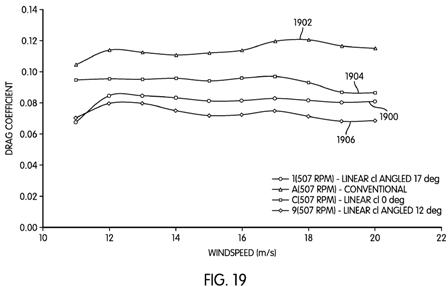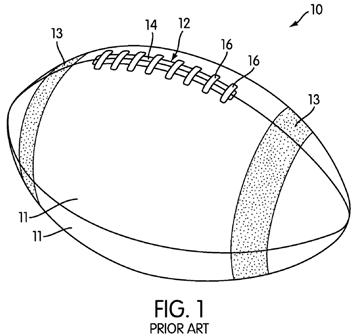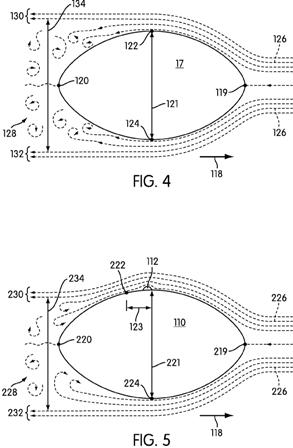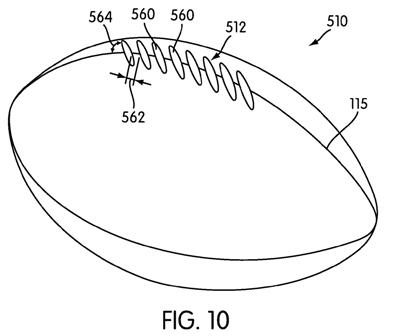How Long Before Football Fields Have to Increase in Length?
Golf purists often argue that the modern golf ball has ruined the game. Is it just a matter of time before the football analysts are making the same arguments and demanded that the football’s performance needs to be rolled back?
Chew on this, today a patent issued to Nike as USPN Lace designs for footballs are provided. The laces have geometries that improve the aerodynamic characteristics of the football during flight. Additionally, the placement of the laces on the football is selected to maximize aerodynamic performance of the football during flight.
The patent goes on to explain:
BACKGROUND
The present invention relates generally to a football with improved laces, and in particular to football having a lace that enhances the aerodynamics of the football.
Most inflatable sports balls are made by one of two main constructions: a traditional construction in which an inner bladder is surrounded by outer panels stitched together to contain the inflated bladder, and a carcass construction in which outer panels are laminated to an inner bladder. Examples of balls of traditional construction include some soccer balls, volleyballs, and footballs which have pieced and stitched outer panels. An example of a ball of carcass construction is a basketball which has an integral cover.
Conventional footballs are constructed in the traditional way by surrounding an inner bladder with an outer skin formed of multiple panels stitched together. In traditional construction, the bladder is inserted into an opening in the outer skin and the outer skin is laced together to close the opening.This traditional lace is still used, even though modern manufacturing methods and materials do not necessarily require lacing together the outer skin of the football. Laces are provided mainly as a guide for proper finger placement or otherwise for gripping assistance. Different lace geometries and materials for improving the grip characteristics of a football have been proposed. See, for example, U.S. Pat. Nos. 5,779,576; 5,941,785; and 6,612,948.
The laces may also impact the aerodynamics of the football during flight. In particular, the laces may assist in reducing drag on the football and stabilizing the rotation of the football, which may allow a player to throw or kick a lace ball further or more accurately than an unlaced ball or a ball having traditional laces. However, the art has not explored the impact of laces on the aerodynamics of a football. Therefore, there exists a need in the art for different geometries of laces for footballs that improve the aerodynamic characteristics of the football.
SUMMARY
A football is provided with laces configured to enhance the aerodynamic performance of the football. The laces may have a number of different geometrical configurations. The laces may also be positioned on the football to enhance a pinwheel effect to stabilize the rotation of the football.
In one aspect, the invention provides a football comprising a body and a lace associated with the body, wherein the lace is configured to enhance an aerodynamic performance of the football.
.
.
.This effect is similar on a football provided with a lace. FIGS. 4 and 5 show the different flow patterns of air around a lace-free ball 17 and first ball 110. FIG. 4 shows the flow pattern around lace-free ball 17, which has a left-to-right travel direction 118. Lace-free ball 17 has a prolate spheroid shape, with a leading edge 119 at a first pointed end of lace-free ball 17 and a trailing edge 120 at the second pointed end of lace-free ball 17. The height of lace-free ball 17 approximately midway between leading edge 119 and trailing edge 120 is the small girth 121 of lace-free ball 17. Small girth 121 is the largest height of lace-free ball 17 between leading edge 119 and trailing edge 120.
As lace-free ball 17 moves through the air, the air flows around lace-free ball 17. The air can be considered to approach lace-free ball 17 near leading edge 119 as areas of laminar flow 126. The currents of air in laminar flow 126 before encountering leading edge of lace-free ball 17 are relatively evenly spaced apart and smooth. Once the currents of air encounter lace-free ball 17, the currents split and begin to flow around lace-free ball 17. Lace-free ball 17 is smoothly tapered, so the currents of air maintain laminar flow characteristics while generally following or “sticking” to the contours of the exterior of lace-free ball 17.
Eventually, however, the currents of air can no longer “stick” to the exterior surface of lace-free ball 17, and the currents transition to turbulent flow. The currents of air closest to the exterior surface of lace-free ball 17 separate from the exterior surface of lace-free ball 17 at a first separation point 122 and a second separation point 124. First separation point 122 and second separation point 124 are typically located at small girth 121 or shifted slightly toward trailing edge 120.
Beyond first and second separation points 122, 124, the currents of air that have separated from the exterior surface of lace-free ball 17 begin to exhibit turbulent flow characteristics and form a turbulent area or wake 128 beyond trailing edge 120. Wake 128 is bounded by areas of laminar flow, a first laminar flow 130 and a second laminar flow 132. The distance between first laminar flow 130 and second laminar flow 132 is the wake height 134. The cross-sectional shape of wake 128 is generally circular, so wake height 134 is the diameter of the wake circle. Therefore, wake height 134 establishes the area of wake 128. Because the turbulent flow within wake 128 has a lower pressure than laminar flow areas 126, 130, and 132, wake 128 causes pressure drag on lace-free ball 17. The amount of pressure drag is proportional to the area of wake 128.
FIG. 5 shows how adding a lace to a football can impact the aerodynamic characteristics of the flight of the football. FIG. 5 shows the flow pattern around first football 110, which, like lace-free ball 17, has a left-to-right travel direction 118. First football 110 has a prolate spheroid shape, with a leading edge 219 at a first pointed end of first football 110 and a trailing edge 220 at the second pointed end of first football 110. The height of first football 110 approximately midway between leading edge 219 and trailing edge 220 is the first small girth 221 of first football 110.
Similar to the discussion of the air flow around lace-free ball 17, the air can be considered to approac
h first football 110 near leading edge 219 as areas of laminar flow 226. The currents of air in laminar flow 226 before encountering leading edge 219 of first football 110 are relatively evenly spaced apart and smooth. Once the currents of air encounter first football 110, the currents split and begin to flow around first football 110. First football 110 is smoothly tapered, so the currents of air maintain laminar flow characteristics while generally following or “sticking” to the contours of the exterior of first football 110.As discussed with respect to lace-free ball 17, the currents of air will reach a point where the currents can no longer “stick” to the exterior surface of first football 110. The currents of air closest to the exterior surface of first football 110 separate from the exterior surface of first football 110 at a first separation point 222 and a second separation point 224. Second separation point 224 is positioned similarly to the position of second separation point 124 on lace-free ball 17. However, prior to encountering first separation point 222, the air currents encounter lace 112, which is shown in this diagram as a simplified bump. Lace 112 trips the flow to prevent the transition from laminar to turbulent flow. Therefore, instead of separating from the exterior surface of first ball 110 near first small girth 221, the flow sticks to the exterior surface of first ball 110. First separation point 222 is shifted a first distance 123 toward trailing edge 220 as compared with first separation point 122 on lace-free ball 17.
As with lace-free ball 17, the currents of air that have separated from the exterior surface of first football 110 form a turbulent area or first wake 228 beyond trailing edge 220. First wake 228 is bounded by areas of laminar flow, a first laminar flow 230 and a second laminar flow 232 to establish first wake height 234. Because second separation point 222 is shifted toward trailing edge 220, first wake height 234 is shorter than wake height 134. Therefore, even though first wake 228 is an area of turbulent flow with lower pressure than laminar flow areas 226, 230, and 232, the area of first wake 228 is reduced as compared to the area of wake 128 for lace-free ball 17. Therefore, the amount of drag experienced by first football 110 is also reduced, due to the presence of lace 112.
The traditional lace design, as shown by lace 12 in FIG. 1, was not selected for aerodynamic considerations. Lace 12 was provided to securely close the skin of the ball after inserting the inner bladder. In testing, a football similar to first football 110 having a lace design like first aerodynamic lace 112 experienced 24.7% less drag than traditional laces like lace 12.
.
.
.
During drag coefficient testing, the drag coefficient versus windspeed was determined for various footballs mounted in a wind tunnel, where each football had a different lace configuration. A sampling of these test results is shown in FIG. 19. In FIG. 19, line 1902 shows the drag coefficient of a football with conventional laces. Line 1904 shows the drag coefficient of a football with an aerodynamic lace, similar to lace 312 shown in FIG. 8, but with a first angle of zero (0) degrees. Line 1900 shows the drag coefficient of a football with an aerodynamic lace, similar to lace 312 shown in FIG. 8, with a first angle of seventeen (17) degrees. Line 1906 shows the drag coefficient of a football with an aerodynamic lace, similar to lace 312 shown in FIG. 8, with a first angle of twelve (12) degrees.While the football with a lace having a first angle of 17 degrees produced the lowest drag coefficient at windspeeds of less than about 11 meters per second, the football with a lace having a first angle 342 of about 12 degrees generally produced the lowest drag coefficient. The 17-degree first angle 342 for the lace is essentially a neutral angle of attack to the air flow over the ball, so the 17-degree first angle 342 lace exposes a minimal cross-sectional area to the air flow over the ball. However, the 12-degree first angle 342 for the lace is slightly oblique to the air flow over the ball. It is speculated that this slightly oblique angle allows the lace to act like a turbulator or vortex generator that trips the air flow to delay separation of the boundary layer as the air flows over the lace. This may reduce the base drag, which may provide the better drag performance of the 12-degree first angle 342 lace over the 17-degree first angle 342 lace. Because of these unexpected results from wind tunnel testing, a first angle 342 of about 12 degrees is preferred.
Selecting the position of a lace on the surface of a football can not only improve the aerodynamic characteristics by reducing drag, but can also help the football to retain its spin. This increases the stability of the throw, allowing the football to travel further and more accurately. This pinwheel effect is shown in FIG. 8. As second football 310 moves in left-to-right travel direction 118, second football 310 spins in right-hand spin direction 344 about longitudinal axis 340. Air approaches second aerodynamic lace 312 as a first current 348. First current 348 encounters second aerodynamic lace 312 at the angle of helical path 346 in the vicinity of second aerodynamic lace 312. Because second aerodynamic lace 312 is not positioned at the same angle as that of helical path 346 at the point at which first current 348 encounters second aerodynamic lace 312, a portion of first current 348 is deflected to form deflected air current 350. The force of this deflection pushes against second aerodynamic lace 312, similar to blowing on the blades of a pinwheel. Second aerodynamic lace 312 is pushed in a first direction 352, contributing to the spin of second football 310.
Oh no, more spin, increased stability, longer and more accurate travel; sounds familiar.
Is this the end of the “prolate spheroid body” that we know and love?




